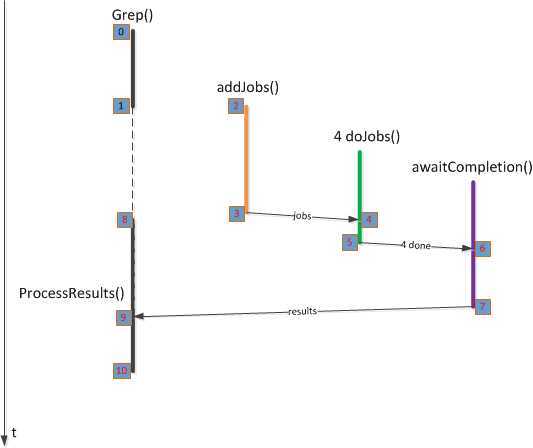标签:style blog http color io os 使用 ar for
断断续续理了一下关于channel的一些概念,现在可以把下面的程序理清楚了。
1. source code
这个程序来自于《Go语言程序设计》 7.2.2 并发的Grep, 程序如下。
package main import ( "bufio" "bytes" "fmt" "io" "log" "os" "path/filepath" "regexp" ) type Job struct { filename string results chan<- Result } type Result struct { filename string fino int line string } var numberOfWorkers = 4 func main() { //retrieve input arguments if len(os.Args) < 3 || os.Args[1] == "-1" || os.Args[1] == "--help" { fmt.Printf("usage: %s <regrex> <files>\n", filepath.Base(os.Args[0])) os.Exit(1) } if lineRx, err := regexp.Compile(os.Args[1]); err != nil { log.Fatalf("invalid regexp: %s\n", err) } else { //do the real work grep(lineRx, os.Args[2:]) } } func grep(lineRx *regexp.Regexp, filenames []string) { jobs := make(chan Job, numberOfWorkers) done := make(chan struct{}, numberOfWorkers) results := make(chan Result, minimun(1000, len(filenames))) go addJobs(jobs, filenames, results) //produce Jobs for i := 0; i < numberOfWorkers; i++ { go doJobs(done, lineRx, jobs) //consume Jobs concurrent } go awaitCompletion(done, results) //wait until all the Jobs done processResults(results) } func addJobs(jobs chan<- Job, filenames []string, result chan<- Result) { for _, filename := range filenames { jobs <- Job{filename, result} } close(jobs) } func doJobs(done chan<- struct{}, lineRx *regexp.Regexp, jobs <-chan Job) { for job := range jobs { job.Do(lineRx) } done <- struct{}{} } func awaitCompletion(done <-chan struct{}, results chan Result) { for i := 0; i < numberOfWorkers; i++ { <-done } //???what will happen to data in results??? close(results) } func processResults(results <-chan Result) { for result := range results { fmt.Printf("%s:%d:%s\n", result.filename, result.fino, result.line) } } func minimun(a int, b int) int { if a <= b { return a } else { return b } } func (job Job) Do(lineRx *regexp.Regexp) { file, err := os.Open(job.filename) if err != nil { log.Printf("error: %s\n", err) return } defer file.Close() reader := bufio.NewReader(file) for lino := 1; ; lino++ { line, err := reader.ReadBytes(‘\n‘) if err != nil { if err != io.EOF { log.Printf("error:%d: %s\n", lino, err) } break } line = bytes.TrimRight(line, "\n\r") if lineRx.Match(line) { job.results <- Result{job.filename, lino, string(line)} } } }
编译程序:
go build program
program a12345b a.txt b.txt c.txt...
2.编写并发go routinue 的一些模式说明
同步通信时需要避开两个陷阱:
陷阱一:主线程提前退出
当其他线程工作没有完成,而主线程提前退出。主线程退出会导致其他线程强制退出,而得不到想要的结果。
常见的解决方式是 让主 gorountine在done通道上等待,根据接收到的消息判断工作是否完成。另一种是使用sync.WaitGroup。
陷阱二:死锁
注意读写线程之间的关系,例如:不关闭 写chanel 会导致 使用range 读数据的 rountine堵塞。
3.程序同步关系图
这里我画出程序执行流程:

0-1 : prepare channels
2: addJobs start
3: in addJobs, close(jobs) to notice the reader
4: in doJobs, finish read jobs(not blocked here), the consumer won‘t be controlled by the producer
5: in do Jobs, close done to inform that the reader is free
6, 7, 8, 9: ....
10: whole program finished
从上述流程上可以看出,都是生产者 通过一定的形式 通知消费者。告知消费者,产品已经生产完成,因此消费者不需要等待了,消费者只需要把剩下的任务完成就可以,消费者不需要受控于生产者了。
而这种通知 通过两种形式完成。
第一种: close channel. 例如: close(jobs), close(results)
第二种:读写done 通道。例如: done <- struct{}{}, <-done。 由于done占用资源比较小,程序中并没有把它关闭。
continue to the github project gocrawl.....
标签:style blog http color io os 使用 ar for
原文地址:http://www.cnblogs.com/harrysun/p/3980501.html